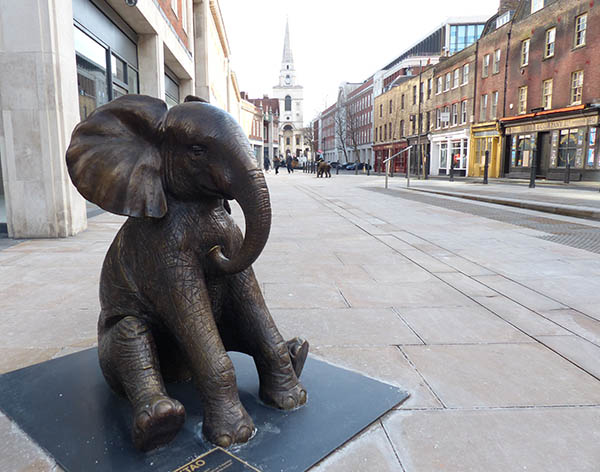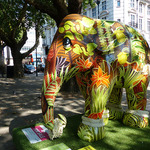Twenty-one bronze elephant sculptures have made their way to London's Spitalfields Market earlier this year and will remain in place until November. Twenty of the statues represent orphaned young elephants that have come into care of the charity Sheldrick Wildlife Trust, and the largest elephant represents the matriarch and protector. Each of the smaller elephant statues gives the name of an orphaned elephant and how it was found, highlighting various difficulties the species face from poaching to human conflict to natural disaster. The statues were created by Gillie and Marc, and the statues help Londoners see the elephants and to raise awareness of their struggles.

Some of the elephants first appeared at London's Marble Arch in December of 2019, but if you did not see them there, then you still have plenty of time to see them at Spitalfields Market before November. The market has now reopened again so visitors can browse and enjoy food and drink, but remember to keep each other safe. Continue scrolling to read about the elephant sculptures and to see more photographs.

Musiara was one of the first elephant sculptures that I discovered at Spitalfields. He was named after the Musiara swamp where he was found dying. Luckily, he was discovered and taken care of. While he was being cared for, he collapsed many times and took a few days before he was able to regain strength.

Several people reported an elephant that had falled into a well in the Ngilai area when they went to water their livestock. The little elephant could not escape from the well and had lost a lot of strength and also hurt himself against the walls of the well while trying to. The herd had no choice but to abandon the elephant. Ngilai was freed and brought back to health.

Maktao is thought to have been orphaned as the result of human conflict with wildlife. He was starving and dehydrated, but he was brought back to health, and he is said to have an active character.

Mukkoka was discovered by chance via a routine patrol piloting the skies when some lone elephant tracks were spotted along the Tiva River.

These two elephants are Emoli and Tagwa. Emoli was a victim of the climate crisis and discovered starving along the Voi River, and it is thought that his mother died from starvation due to a drought. Tagwa was rescued from Mount Kenya and suspected an orphan from human interference.

Malkia became an orphan due to the age of her mother, who was a well-known elephant who was older and who also suffered and probably met an earlier death due to drought. Malkia was rescued as she was not yet weened when her mother died.
Kiombo was discovered in the Kiombo area as an orphan and suspected that he had been without his mother, which was discovered deceased some miles away, for a long while. Attempts were made to try to get other herds to adopt the orphan, but it never worked out, so they had intervene. This elephant settled into his new life at the rescue and his routine well.
Maisha was a victim of droughts, and it is likely that she fell behind and became separated from her herd after becoming too weak to keep up with the herd's search for food and water.

Ambo was an orphan from Amboseli area. Attempts were made to reunite him with his herd, but they failed.

Kiasa was six months old and still required her mother's milk when she was found on her own.

Barsilinga's mother was killed by poachers. The injured mother was tended to by vets, but they were unable to save her life. The baby Barsilinga was only a week old, so they had to arrange her care.

Tamiyoi was discovered abandoned and trapped down a well in nothern Kenya. She was rescued by Kenya Wildlife Service and then passed on her care.

Luggard was shot in the legs, and the only way to save his life was to provide immediate intensive care. This meant that he had to be taken away from his herd.

Mbegu was injured by attacking humans. She is a maternal elephant and enjoys mothering the younger orphans.

Enkesha's truck was caught in a poacher's snare, and she required immediate treatment to save her trunk and her life.
Sattao was discovered aged three months with predator attack bite marks; he was found away from his herd and orphaned.

Jotto, which means "heat" in Swahili, was discovered in a well in the hottest month. He was discovered by local herdsmen and rescued.

Ndotto was rescued by helicopter in the mountains he is named after and was found following a herd of livestock. He was a newborn.

Mwashoti was a poaching victim; a snare almost severed his leg.
The largest elephant is the matriarch elephant that represents the charity.
The bronze elephant sculptures can be discovered in and around Spitalfields Market. Some of them are inside the market, so you will need to ensure that you visit during trading hours in order to see all of them.







Leave a comment